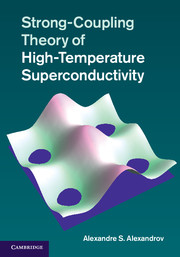Book contents
- Frontmatter
- Contents
- Preface
- 1 Coulomb and Fröhlich interactions
- 2 Small polarons
- 3 Inverse-coupling expansion technique
- 4 High-temperature superconductivity
- 5 Converting boson–fermion mixtures
- 6 Superconductivity from repulsion: Theoretical constraints
- 7 Theory and experiment: Confirmed predictions
- 8 Experiments explained: Normal state
- 9 Experiments explained: Superconducting state
- 10 Further predictions
- References
- Index
6 - Superconductivity from repulsion: Theoretical constraints
Published online by Cambridge University Press: 05 May 2013
- Frontmatter
- Contents
- Preface
- 1 Coulomb and Fröhlich interactions
- 2 Small polarons
- 3 Inverse-coupling expansion technique
- 4 High-temperature superconductivity
- 5 Converting boson–fermion mixtures
- 6 Superconductivity from repulsion: Theoretical constraints
- 7 Theory and experiment: Confirmed predictions
- 8 Experiments explained: Normal state
- 9 Experiments explained: Superconducting state
- 10 Further predictions
- References
- Index
Summary
Motivation
With few exceptions [131] it is widely accepted that the conventional Bardeen–Cooper–Schrieffer (BCS) theory [12] and its intermediate-coupling Eliashberg extension [14] do not suffice to explain high-temperature superconductivity. As shown in the preceding chapters the true origin of high-temperature superconductivity could be found in a proper combination of the bare Coulomb repulsion with the bare electron–phonon interaction in the framework of the many-body polaron theory [51] beyond the BCS–Eliashberg approximation.
Nevertheless some researchers have maintained that the repulsive electron–electron interaction alone should provide pairing at high temperatures without phonons despite substantial experimental evidence that the EPI is an important player and needs to be included in the successful theory of high-Tc superconductivity. Following the original proposal by P. W. Anderson, many authors [22, 74] argued that the electron–electron interaction in high-temperature superconductors was strong but repulsive providing high Tc without phonons via superexchange and/or spin fluctuations in the d-wave pairing channel (l = 2). A motivation for this concept can be found in the earlier works by Kohn and Luttinger (KL) [132, 133] who showed that the Cooper pairing of fermions with any weak repulsion was possible since the two-particle interaction induced by many-body effects is attractive for pairs with large orbital momenta, l ≫ 1.
- Type
- Chapter
- Information
- Publisher: Cambridge University PressPrint publication year: 2013



